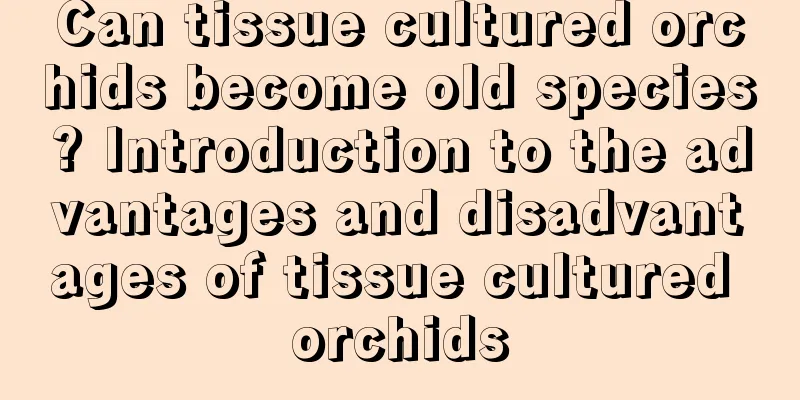Can tissue cultured orchids become old species? Introduction to the advantages and disadvantages of tissue cultured orchids

1. Can it change?Can't become an old species. Old seeds refer to the offspring seedlings obtained by reproduction completely in the natural environment, which can better maintain the characteristics of the original seeds. Tissue culture seedlings are made from mother plants and are artificially cultivated under sterile conditions to cultivate, grow, develop and regenerate complete plants. Therefore, tissue culture seedlings cannot become old varieties. Although both of them use mother plants for reproduction, there are still big differences between them. The roots of tissue culture will be whiter, thinner and smoother than those of old varieties. 2. Advantages and disadvantages of tissue culture1. Advantages: Tissue culture of orchids can allow some precious orchids to be reproduced in large quantities. In addition to being relatively cheap, it can make many rare varieties of orchids accessible to ordinary people. It can also meet the growing demand for orchid seedlings in the market. Otherwise, relying solely on wild seedlings is far from enough to meet the needs of the public. Secondly, tissue culture orchids can be used to cultivate exactly the same orchids, with no difference in flower color and leaf shape. In addition, detoxification can be carried out through tissue culture to make it non-toxic seedlings. 2. Disadvantages: Breeding is difficult. Because tissue culture orchids are cultivated in a sterile environment, the temperature and humidity are strictly controlled. Therefore, its resistance is relatively poor, it has relatively high requirements for temperature and humidity, and it is not resistant to diseases. In other words, it is much more delicate than wild orchids. The quality of tissue-cultured orchids is prone to deterioration, the leaves are shorter, and it is very difficult to bloom. The growth of tissue-cultured orchids is unstable, and they are prone to problems such as short and thin leaves, difficulty in flowering, seedlings falling over, and weak fragrance. In addition, the flower color and leaf shape of tissue-cultured orchids will not change, and they lack individual beauty. Wild orchids are rarely exactly alike; even orchids of the same species on the same mountain will have slight differences due to their different growing locations. |
<<: Breeding techniques for North American alligator turtles
Recommend
Tips for pruning witch hazel after flowering
Pruning principles for witch hazel during floweri...
How to cultivate Isuzu jade in color
Plant characteristics First, understand its prefe...
How and when to plant ginger
The best time to plant ginger The best time to pl...
How does Bauhinia spend the winter?
1. Water control In winter, water and fertilizer ...
What soil is used to grow pennywort
1. Growth Habits It prefers sunlight and can be g...
Cultivation methods and precautions of rice bamboo
Rice bamboo, also known as Phoenix Tail Bamboo, i...
What is mustard greens?
What is mustard greens? Mustard greens are a vege...
How to root Clivia
1. Hydroponics 1. Water immersion method/medicine...
What is the difference between yarrow and motherwort?
1. Leaf Difference The leaves of Yarrow are sessi...
Is Wisteria easy to grow?
Wisteria is a very easy plant to grow. It has str...
Does Andrographis paniculata prefer shade or sun?
Does Andrographis paniculata prefer shade or sun?...
This flower won't die no matter how hard you try. Why don't you get one?
1. A must-have for lazy people - it won't die...
Is Hubei suitable for growing litchi trees? Can they bear fruit?
Planting lychee trees in Hubei Litchi can be grow...
Are bananas tropical crops? Do they grow in tropical areas?
Is banana a tropical crop? Bananas are tropical c...
How to save watermelon seeds
How to save watermelon seeds When watermelon matu...









